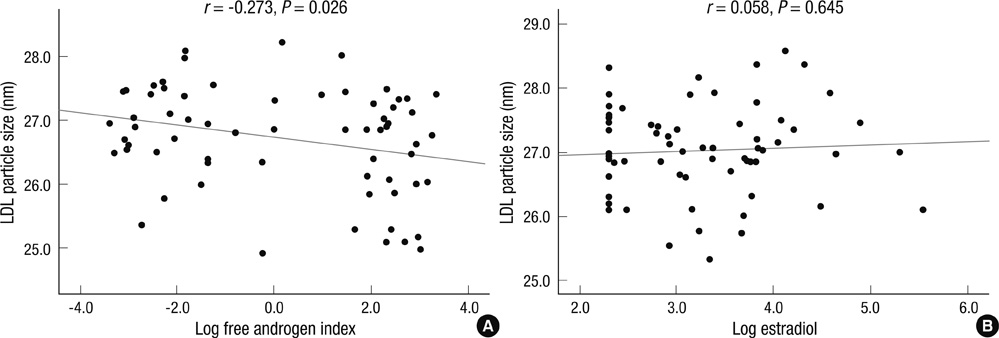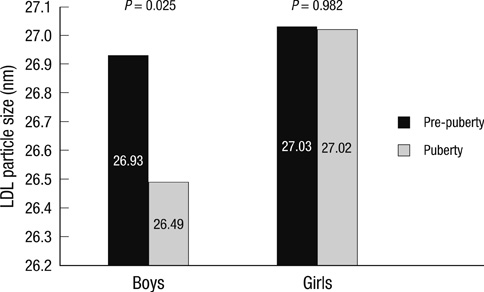J Korean Med Sci.
2011 Apr;26(4):534-539. 10.3346/jkms.2011.26.4.534.
A Higher Burden of Small Low-density Lipoprotein Particles is Associated with Profound Changes in the Free Androgen Index in Male Adolescents
- Affiliations
-
- 1Department of Endocrinology and Metabolism, Ajou University School of Medicine, Suwon, Korea. djkim@ajou.ac.kr
- 2Department of Internal Medicine, Seoul National University Bundang Hospital, Seoul National University College of Medicine, Seongnam, Korea.
- 3Department of Pediatrics, Ajou University School of Medicine, Suwon, Korea.
- 4Dr. Cho's Internal Medicine Clinic, Seoul, Korea.
- KMID: 1777884
- DOI: http://doi.org/10.3346/jkms.2011.26.4.534
Abstract
- From a young age, males are at higher cardiovascular risk than females. Dyslipidemia, including a higher burden related to small low-density lipoproteins (LDL), plays an important role in precipitating atherosclerosis in both males and females. We investigated sex differences in atherogenic lipoprotein burden and the independent predictors of LDL particle size in children and adolescents. We measured the concentrations of total testosterone, sex hormone-binding globulin, estradiol, total cholesterol, triglyceride, LDL cholesterol, HDL cholesterol, and LDL particle size in 135 children and adolescents (67 boys, 68 girls). The free androgen index was significantly and negatively correlated with LDL particle size (r = -0.273, P = 0.026) in boys, but estrogen and LDL particle size were not related. In a stepwise multiple regression analysis adjusted for body mass index, age, and homeostasis model assessment for insulin resistance, free androgen index was still an independent predictor of LDL particle size in boys (R2 = 0.075, P = 0.026). The prominent decrease in LDL particle size along with increased testosterone concentrations in males might explain why they are more likely to display atherogenic dyslipidemia from adolescence.
Keyword
MeSH Terms
Figure
Reference
-
1. Castelli WP, Garrison RJ, Wilson PW, Abbott RD, Kalousdian S, Kannel WB. Incidence of coronary heart disease and lipoprotein cholesterol levels. The Framingham Study. JAMA. 1986. 256:2835–2838.2. Kwon SW, Yoon SJ, Kang TS, Kwon HM, Kim JH, Rhee J, Lee SJ, Park JK, Lim JY, Yoon YW, Hong BK. Significance of small dense low-density lipoprotein as a risk factor for coronary artery disease and acute coronary syndrome. Yonsei Med J. 2006. 47:405–414.3. Genest JJ, McNamara JR, Salem DN, Schaefer EJ. Prevalence of risk factors in men with premature coronary artery disease. Am J Cardiol. 1991. 67:1185–1189.4. Hamsten A, Walldius G, Szamosi A, Dahlen G, de Faire U. Relationship of angiographically defined coronary artery disease to serum lipoproteins and apolipoproteins in young survivors of myocardial infarction. Circulation. 1986. 73:1097–1110.5. Austin MA, King MC, Vranizan KM, Krauss RM. Atherogenic lipoprotein phenotype. A proposed genetic marker for coronary heart disease risk. Circulation. 1990. 82:495–506.6. Gardner CD, Fortmann SP, Krauss RM. Association of small low-density lipoprotein particles with the incidence of coronary artery disease in men and women. JAMA. 1996. 276:875–881.7. Krauss RM. Dense low density lipoproteins and coronary artery disease. Am J Cardiol. 1995. 75:53B–57B.8. Lamarche B, Tchernof A, Moorjani S, Cantin B, Dagenais GR, Lupien PJ, Després JP. Small, dense low-density lipoprotein particles as a predictor of the risk of ischemic heart disease in men. Prospective results from the Quebec Cardiovascular Study. Circulation. 1997. 95:69–75.9. Slyper AH. Low-density lipoprotein density and atherosclerosis. Unraveling the connection. JAMA. 1994. 272:305–308.10. Carr MC, Hokanson JE, Zambon A, Deeb SS, Barrett PH, Purnell JQ, Brunzell JD. The contribution of intraabdominal fat to gender differences in hepatic lipase activity and low/high density lipoprotein heterogeneity. J Clin Endocrinol Metab. 2001. 86:2831–2837.11. McNamara JR, Campos H, Ordovas JM, Peterson J, Wilson PW, Schaefer EJ. Effect of gender, age, and lipid status on low density lipoprotein subfraction distribution. Results from the Framingham Offspring Study. Arteriosclerosis. 1987. 7:483–490.12. Shimabukuro T, Sunagawa M, Ohta T. Low-density lipoprotein particle size and its regulatory factors in school children. J Clin Endocrinol Metab. 2004. 89:2923–2927.13. Anderson GL, Limacher M, Assaf AR, Bassford T, Beresford SA, Black H, Bonds D, Brunner R, Brzyski R, Caan B, Chlebowski R, Curb D, Gass M, Hays J, Heiss G, Hendrix S, Howard BV, Hsia J, Hubbell A, Jackson R, Johnson KC, Judd H, Kotchen JM, Kuller L, LaCroix AZ, Lane D, Langer RD, Lasser N, Lewis CE, Manson J, Margolis K, Ockene J, O'Sullivan MJ, Phillips L, Prentice RL, Ritenbaugh C, Robbins J, Rossouw JE, Sarto G, Stefanick ML, Van Horn L, Wactawski-Wende J, Wallace R, Wassertheil-Smoller S. Women's Health Initiative Steering Committee. Effects of conjugated equine estrogen in postmenopausal women with hysterectomy: The Women's Health Initiative Randomized Controlled Trial. JAMA. 2004. 291:1701–1712.14. Mackey RH, Kuller LH, Sutton-Tyrrell K, Evans RW, Holubkov R, Matthews KA. Hormone therapy, lipoprotein subclasses, and coronary calcification: the Healthy Women Study. Arch Intern Med. 2005. 165:510–515.15. Reinehr T, Kiess W, de Sousa G, Stoffel-Wagner B, Wunsch R. Intima media thickness in childhood obesity: relations to inflammatory marker, glucose metabolism, and blood pressure. Metabolism. 2006. 55:113–118.16. Choi YJ, Jo YE, Kim YK, Ahn SM, Jung SH, Kim HJ, Chung YS, Lee KW, Kim DJ. High plasma concentration of remnant lipoprotein cholesterol in obese children and adolescents. Diabetes Care. 2006. 29:2305–2310.17. Alan HB. Tietz clinical guide to laboratory tests. 2006. 4th ed. St. Louis, MO: Saunders.18. Miyashita M, Okada T, Kuromori Y, Harada K. LDL particle size, fat distribution and insulin resistance in obese children. Eur J Clin Nutr. 2006. 60:416–420.19. Stan S, Levy E, Delvin EE, Hanley JA, Lamarche B, O'Loughlin J, Paradis G, Lambert M. Distribution of LDL particle size in a population-based sample of children and adolescents and relationship with other cardiovascular risk factors. Clin Chem. 2005. 51:1192–1200.20. Steinbeck KS, Bermingham MA, Mahajan D, Baur LA. Low-density lipoprotein subclasses in children under 10 years of age. J Paediatr Child Health. 2001. 37:550–553.21. Freedman DS, Bowman BA, Otvos JD, Srinivasan SR, Berenson GS. Levels and correlates of LDL and VLDL particle sizes among children: the Bogalusa heart study. Atherosclerosis. 2000. 152:441–449.22. Haffner SM, Laakso M, Miettinen H, Mykkänen L, Karhapää P, Rainwater DL. Low levels of sex hormone-binding globulin and testosterone are associated with smaller, denser low density lipoprotein in normoglycemic men. J Clin Endocrinol Metab. 1996. 81:3697–3701.23. Herbst KL, Amory JK, Brunzell JD, Chansky HA, Bremner WJ. Testosterone administration to men increases hepatic lipase activity and decreases HDL and LDL size in 3 wk. Am J Physiol Endocrinol Metab. 2003. 284:E1112–E1118.24. Tan KC, Shiu SW, Kung AW. Alterations in hepatic lipase and lipoprotein subfractions with transdermal testosterone replacement therapy. Clin Endocrinol (Oxf). 1999. 51:765–769.25. Berg G, Schreier L, Geloso G, Otero P, Nagelberg A, Levalle O. Impact on lipoprotein profile after long-term testosterone replacement in hypogonadal men. Horm Metab Res. 2002. 34:87–92.26. Pérez-López FR, Larrad-Mur L, Kallen A, Chedraui P, Taylor HS. Gender differences in cardiovascular disease: hormonal and biochemical influences. Reprod Sci. 2010. 17:511–531.27. Sutton-Tyrrell K, Wildman RP, Matthews KA, Chae C, Lasley BL, Brockwell S, Pasternak RC, Lloyd-Jones D, Sowers MF, Torréns JI. SWAN Investigators. Sex-hormone-binding globulin and the free androgen index are related to cardiovascular risk factors in multiethnic premenopausal and perimenopausal women enrolled in the Study of Women Across the Nation (SWAN). Circulation. 2005. 111:1242–1249.28. Kapoor P, Luttrell BM, Williams D. The free androgen index is not valid for adult males. J Steroid Biochem Mol Biol. 1993. 45:325–326.29. Ly LP, Handelsman DJ. Empirical estimation of free testosterone from testosterone and sex hormone-binding globulin immunoassays. Eur J Endocrinol. 2005. 152:471–478.
- Full Text Links
- Actions
-
Cited
- CITED
-
- Close
- Share
- Similar articles
-
- A Study of Estrogen only Therapy and Estrogen Plus Androgen Combination Therapy in Surgical Menopause Patients
- Small Dense Low-density Lipoprotein and Cardiovascular Disease
- Changes in the Serum Level of High Density Lipoprotein-cholesterol after Smoking Cessation among Adult Men
- Interaction between Glucose and Lipid Metabolism: More than Diabetic Dyslipidemia
- Serum Insulin, Insulin-like Growth Factor-I and Insulin-like Growth Factor Binding Protein-3 Levels in Obese Adolescents



